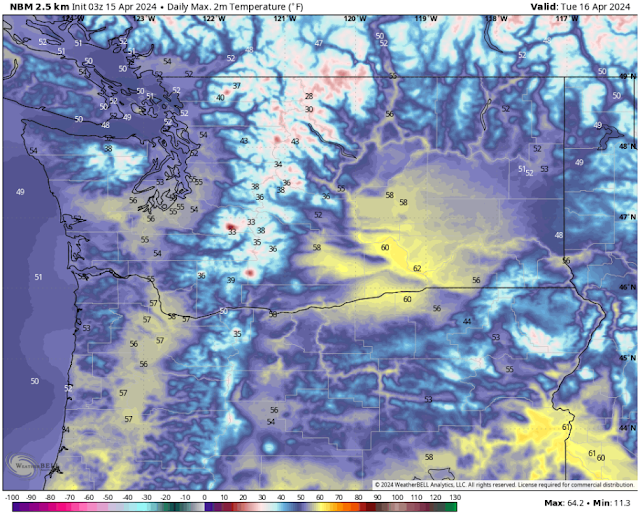FastCast--Wednesday, May 1 to Sunday, May 5:
After a few days of showers, a relatively dry remainder of the work week is expected. Partly sunny conditions are expected on Wednesday, with highs reaching the upper 50s to low 60s. Thursday will be the best day of the week, with mostly sunny skies and highs in the mid 60s across the region. Clouds will return on Friday, but highs will remain in the mid to upper 60s. However, rain will move in by late Friday evening, continuing at times through late Sunday. Precipitation totals look to be on the heavier side for this round of rain, with amounts of 0.5-1.5" possible, depending on which forecast we look at. Temperatures on the weekend will decrease to the mid 50s, with lows from Friday to Sunday in the mid 40s. Notably, lows on Wednesday and Thursday will be in the mid to upper 30s, with a slight chance for frost in some outlying areas on Wednesday morning. Stay tuned over the next few days for more information about the weekend forecast.
----------------------------------------------------------------------------
Continue reading the full blog below!
A couple nicer days are ahead across Washington, following a few days of showers. Let's take a look at the forecast, and a look ahead to a potentially wetter weekend.
Below is the forecast for morning lows on Wednesday from the NWS NBM model.
Expect morning lows in the mid to upper 30s outside the metro area, with the cities remaining in the upper 30s to low 40s. Eastern Washington will drop to the low to mid 30s. Any areas below approximately 35-36° have a potential for frost, so be aware of this possibility.
Highs on Wednesday will be an increase from Tuesday, as seen below in the NWS NBM forecast.
On Wednesday, expect lowland highs in the upper 50s to low 60s, coastal highs in the mid 50s, Willamette Valley highs in the upper 50s, and Eastern Washington highs in the upper 50s near Spokane and Ellensburg to the mid to upper 60s in the Columbia Basin.
Next, let's take a look at highs on Thursday, which will be the sunniest day in Western Washington, albeit not the warmest. The NWS NBM forecast is below.
On Thursday, the lowlands will reach the low to mid 60s, with the Willamette Valley and coast reaching the upper 50s to low 60s. Eastern Washington will reach the low 60s near Spokane to upper 60s in the Columbia Basin.
Friday will be the warmest day for awhile, but Western Washington's skies will be mostly cloudy as our wet weekend system moves in. Below is the NWS NBM forecast.
Expect highs on Friday to reach the mid to upper 60s in the lowlands, with the coast reaching the upper 50s, the Willamette Valley reaching the upper 50s to mid 60s, and Eastern Washington reaching the mid 60s to mid 70s.
This forecast shows heavy rain totals of 1-1.5" from Seattle southward through the Willamette Valley, with 0.3-0.9” from Seattle northward. This forecast doesn’t necessarily encompass rain totals for the whole region over the entire weekend, so stay tuned for more information over the next few days!



















































